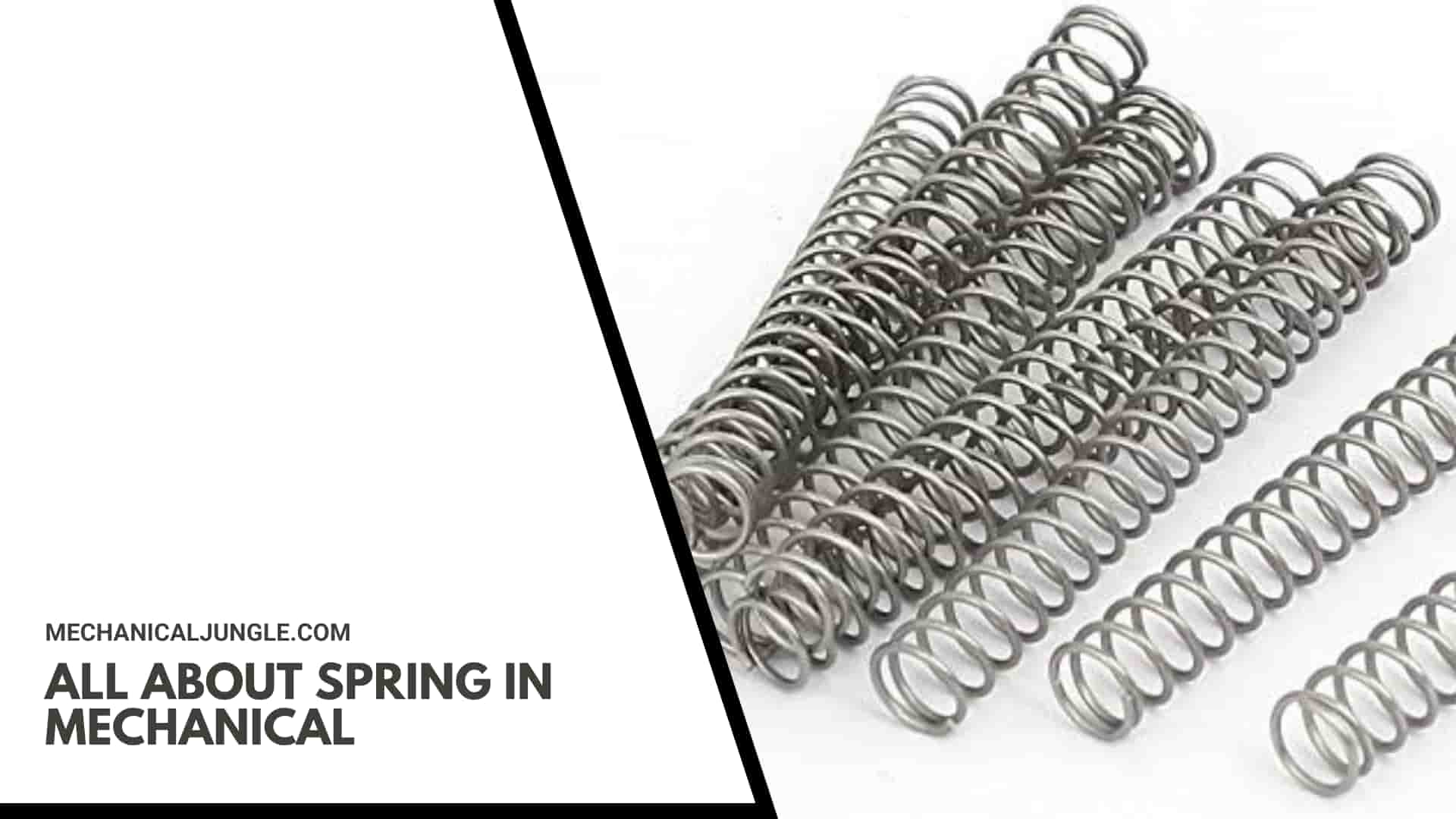
What Is Spring in Mechanical?
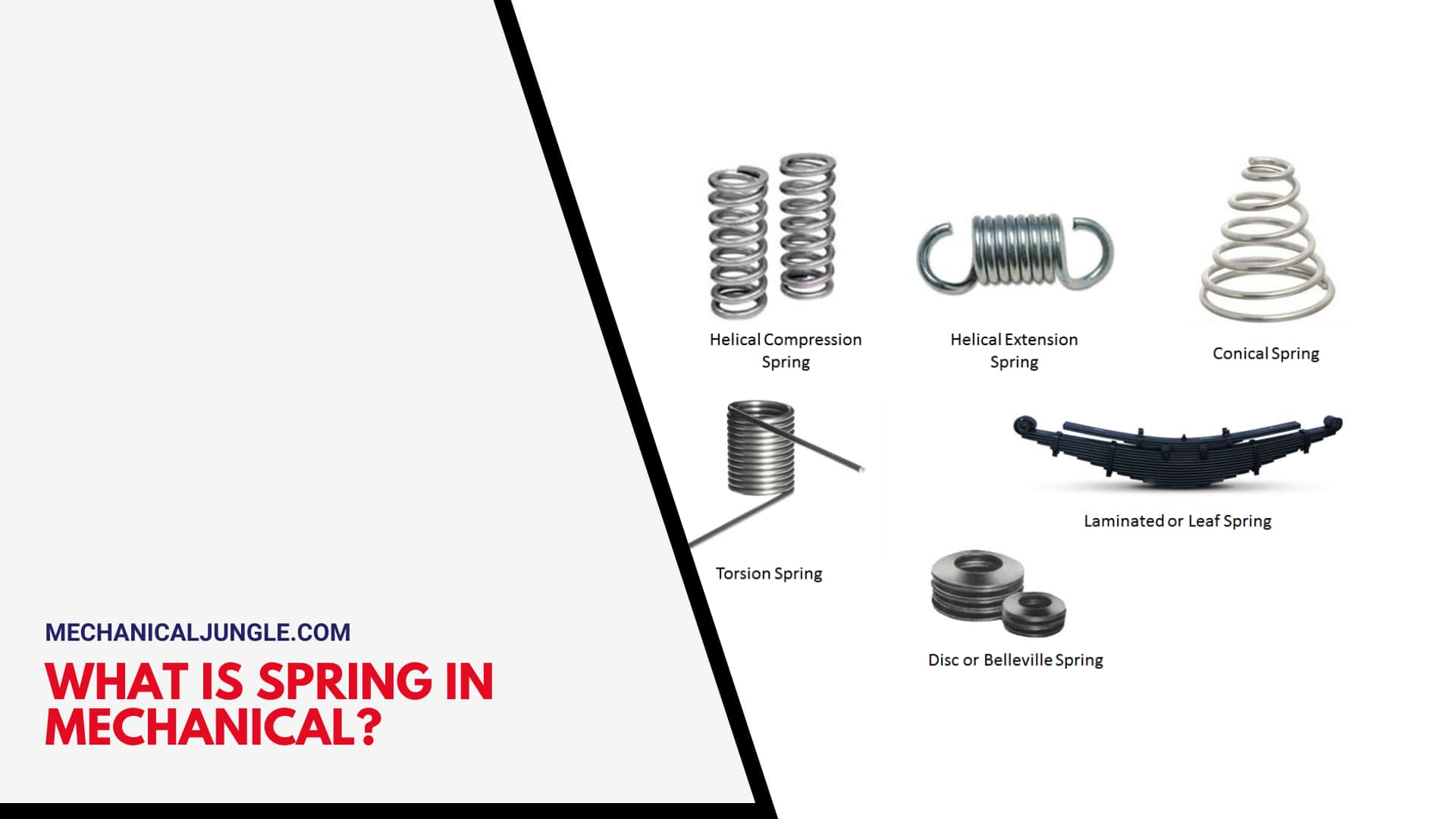
Spring are mechanical devices that pull, push, wind, support, lift, or protect. They are mainly used to provide force in mechanical assemblies – compressive, tensile, or torsion – where they can be used to lift engine valves, open die sets, or hold batteries, just to name a few examples.
Springs are usually wound with wire but can be made of solid steel, manufactured as cylinders, formed as bags, sealed with steel, or assembled from other springs. Ordinary wire springs exhibit force whose magnitude increases linearly as the spring is pushed, pulled, or twisted.
Mechanical springs are a device that can also be defined as an elastic or flexible member whose main functions are to deflect under the action of the load and fix its original shape when the load is removed.
It is also used for storing energy. Today we learn about the types of springs used for various purposes in mechanical. The spring is an elastic machine element that can deflect under the application of a load. When the loads are removed, it regains their original position.
In other words, a spring is a mechanical object made of a material with a very high yield strength to restore elasticity. It is used to absorb shocks in various machines, or it is also designed to transfer shocks and vibrations on various critical machine members.
Types of Spring in Mechanical:
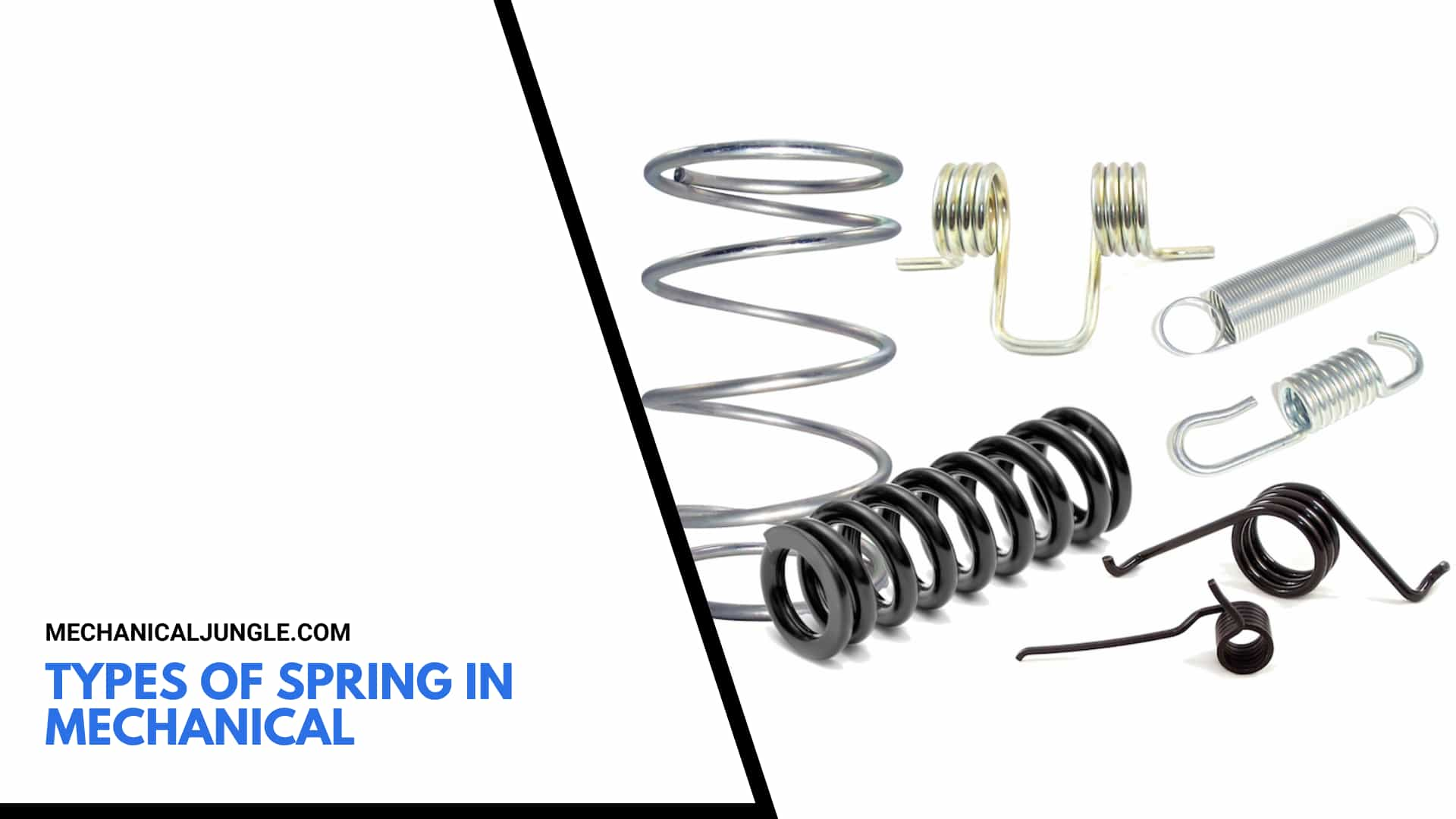
#1. Compression Springs
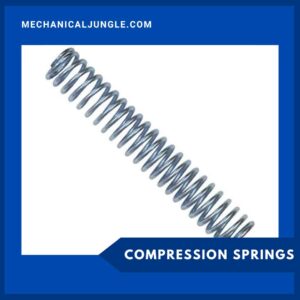
Compressed springs are helically coiled wires that are designed to provide compressive force. Under increasing load, the space between the coils closes until the compressed length of the spring is reached when the coils touch.
The main specifications include spring rate, helix type, spring end type, wire diameter, material, different diameter, and free length.
Compression springs are mainly used in manufacturing applications, where a variable and opposing force is required between components. The ends may be open (left as cut) or closed (where the last coil is flattened against the adjacent coil to produce a square end relative to the axis).
Increasing the ends can also be achieved by grinding the surface of the final coil. Compression springs, while generally fashioned from wire, can also be made specifically for demanding applications.
#2. Torsion Springs
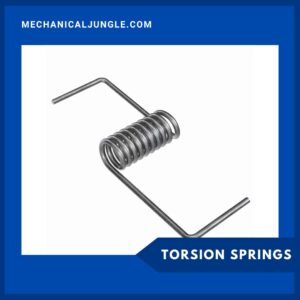
Torsion springs are helical, or flat spirals coil or strips used to apply or resist torque loads. Key specifications include spring rate, spring end type, wire diameter, material, and torque rating in a known position.
Torsion springs are mainly used in manufacturings applications as components for various motion control.
They come in two basics types, helical or (coils) torsion springs, like compression or expansion springs, and act in radial directions in applying torque axially to produce tension or compression, and spiral torsion springs. , As the concentric spiral lesion usually flat, or rectangular, from the stocks.
Many different types of torsions spring are available in automated machinery, with applications ranging from clocks and clocks to motion control.
#3. Extension Springs
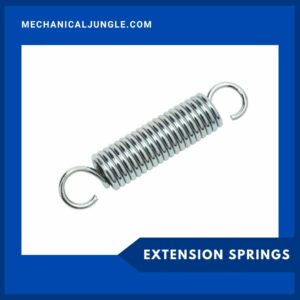
Expansion springs are helically coiled wires, which are designed to provide an opposing force when stretched. Key specifications include spring rate, helix type, spring end type, wire diameter, material, and free and maximum extended length.
Extension springs are mainly used in manufacturing applications where a variable, opposing force is required between two components.
Materials are available based on several sizes, spring rates, and required available forces. The end a usually formed in the shape of a hook or loop & can also be custom-made.
A variety of spring ends are used with extension springs, and many of these are standardized for specific applications, typically formed in the shape of a hook or loop, and can also be custom made.
#4. Constant Force Springs
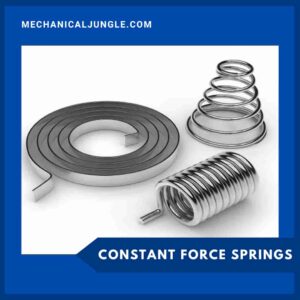
Clocks have clock springs or constants force springs. A constant force spring is a tightly wound band of steel that resembles a roll of tape.
A load forces the springs to contract, & when it is removed, the spring rebels with constant forces. Constant force spring is also found in wind-up toys and similar devices.
#5. Drawbar Springs
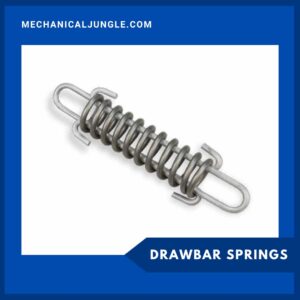
Drawbar springs are coil compression springs, including U-shaped wire forms, inserted for use in extension applications. The drawbar spring combines the application of tension of the extension spring with the positive stop feature of the compressions spring.
Key features include free length, maximum spring deflection, and wire diameter. Drawbar springs are mainly used in applications where a tension-producing spring is required, where the self-limiting feature of compression springs is also required.
A typical use for drawer spring supports porch swings, where the spring cannot be loaded from the point of failure dues to the self-limiting property of the compression springs.
#6. Volute Springs
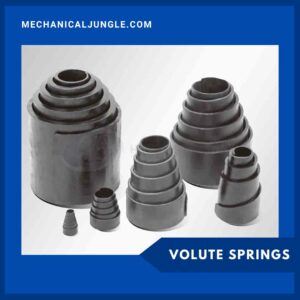
Volute springs are wound flat metal strips together, forming helical spirals that are commonly used in compression applications. Key features include the intended application, diameter, stroke, material, and final attachment style.
Volute springs are mainly used in applications where a compression spring is required for a long fatigue life or a repetition of high spring force. They come in different sizes depending on applications & force, and materials.
Some solute springs are single-ended, while others are double. An easily recognizable use of solute spring is the compression spring found in high-quality nail clippers or pruning shears.
#7. Garter Springs
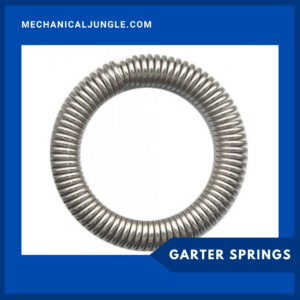
Garter springs are spring coils whose ends join to form spherical springs that are used to provide a radial force to components that may have a variable load. A common use of garters springs is in hydraulic, pneumatic, & radial shaft seals, where they provide a slight inward force on the sealing lips.
#8. Flat Springs
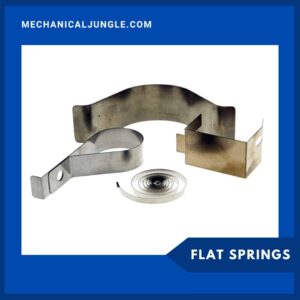
Flat springs are strips or metal straps, or assemblies of such type, that are made to form a repeating counterforce when compressed or displaced and used for positioning or contact. Key features include the intended application, flat spring type, and spring and type.
Flat springs are mainly used in applications where a repetitive counterforce is required to control the speed or load by applying contact and force.
They are available in various sizes, types, materials, as well as mounting types or sizes. Some easily identified examples of flat springs are the imbalance in flat battery contacts, vehicle leaf springs, and sliding screen windows.
#9. Gas Springs
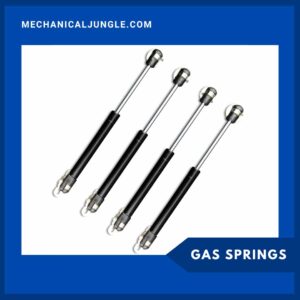
Gas springs are mechanical devices consists of a cylinder and a rod, which use pressure from the pre-charge of nitrogen, or other inert gases, to create a force bias on the piston or rod. Key features include intended application, stroke, compressed length, extended length, force, as well as features.
Gas springs are mainly used in the automobile industry to lift and/or reduce the hood or hatch. They are available in various sizes and stroke lengths depending on the application & load requirements. Others applications include use on office chairs for seat height adjustment.
#10. Air Springs
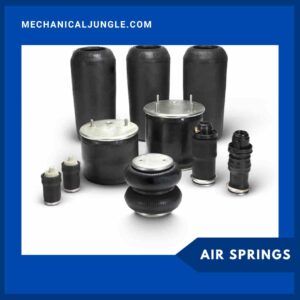
Air springs are air pressure pressures or bladder-type devices of various sizes and shapes and are used to provide activation, shock absorption, and vibration isolation. Key features include the intended application, type, style, physical dimensions, mounting type as well as features.
Air springs are mainly used in machine applications such as vehicle suspensions for shock absorption and as machine mounts for vibration isolation.
They are available in various types & sizes depending on load requirements and application. Other uses include lifting, compressing, bending, etc. Air spring used for vibration isolation is also known as air cushions.
#11. Other Springs
Springs that are assembled into components for special applications are called spring assemblies. The springs used to protect the hydraulic line are called protective coil springs. Hydraulic springs use specials hydraulics fluid in very short stroke applications and are found in die springs.
#12. Leaf Springs

It is an arc-shaped spring, made up of strips of metal one after the other and held together using a nut and bolt or clamps.
It is a widely used suspension system for commercial vehicles such as buses, trucks, etc. This spring is capable of withstanding large forces in small areas. It is usually made of steel, graphite epoxy, carbon epoxy.
#13. Special Purpose Springs
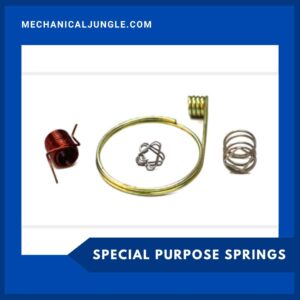
Air spring, gas spring, extension spring, greater spring, etc., fall under the category of special purpose springs.
As the name implies, “special purpose,” meaning that these springs are not widely used, but still in some cases like vice-grip pliers, carburetor, trampoline, washing device, even We also use extension spring in toys.
Nowadays, we use an air spring, where the air is used to pump the bladder, which helps us to absorb shock and vibration completely. So these types of springs fall under the category of special purpose springs.
Spring Materials:
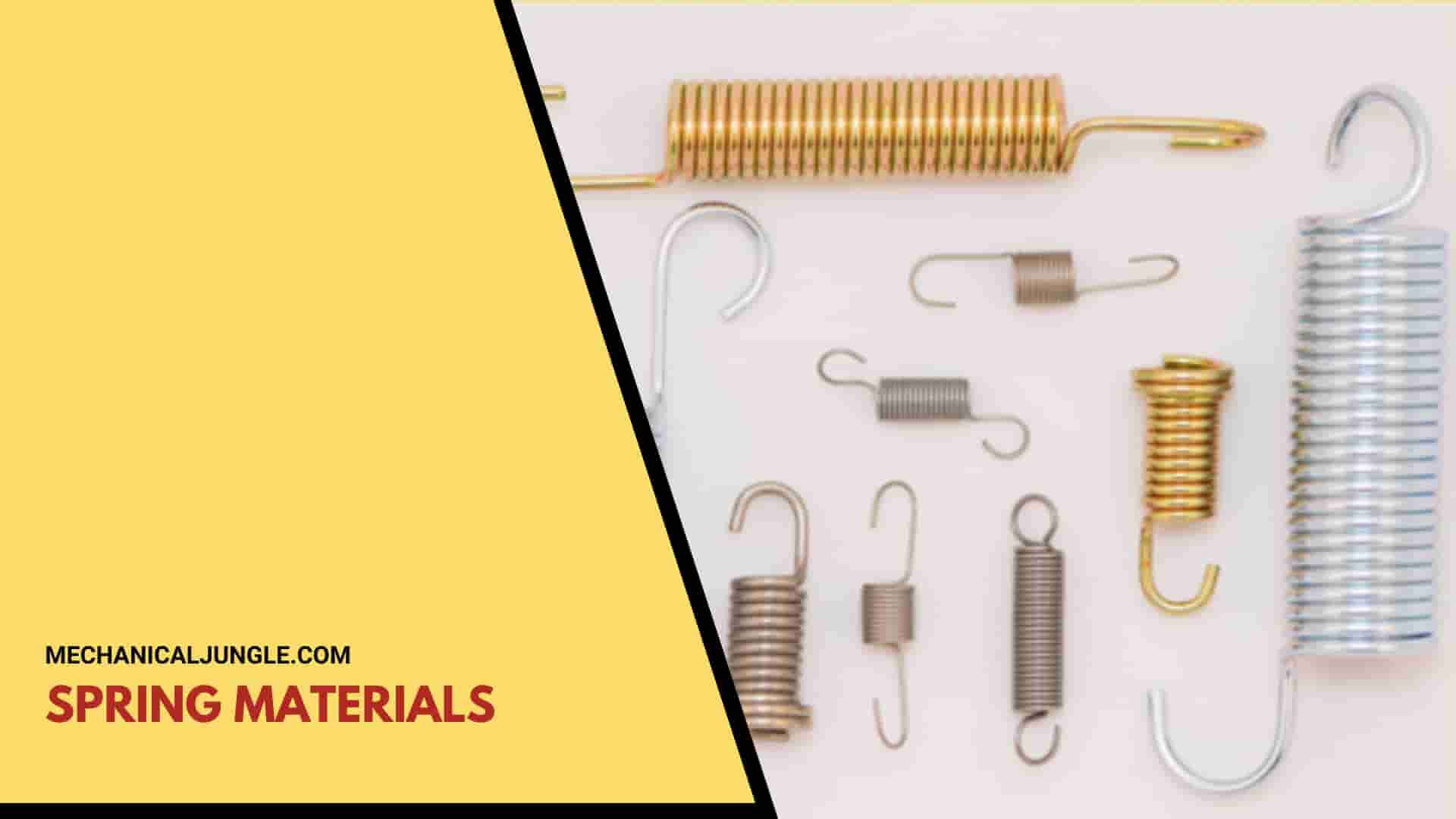
Springs are made of the following materials:
- Hard draw wires:- These are general purpose springs, where we require low-temperature resistance and low tension; we can use these types of spring materials.
- Graphite epoxy:- It is used in high-strength springs such as leaf springs.
- Carbon epoxy:- It is made of carbon fiber and has a high load-bearing capacity; this material is also used in high-power applications such as automobiles and locomotives.
- Stainless steel:- Nowadays, stainless steel is widely used in the manufacture of spring.
- Phosphor Bronze:- This type of spring is used in the electrical industry because the material has good electrical conductivity & good resistance to corrosion.
- Chrome Silicon:- These types of springs can be used in high temperatures up to 250 ° C.
- Chrome Vanadium:- This type of spring has good thermal conductivity up to 220 ° C and also has good fatigue resistance.
Application of Spring in Mechanical:
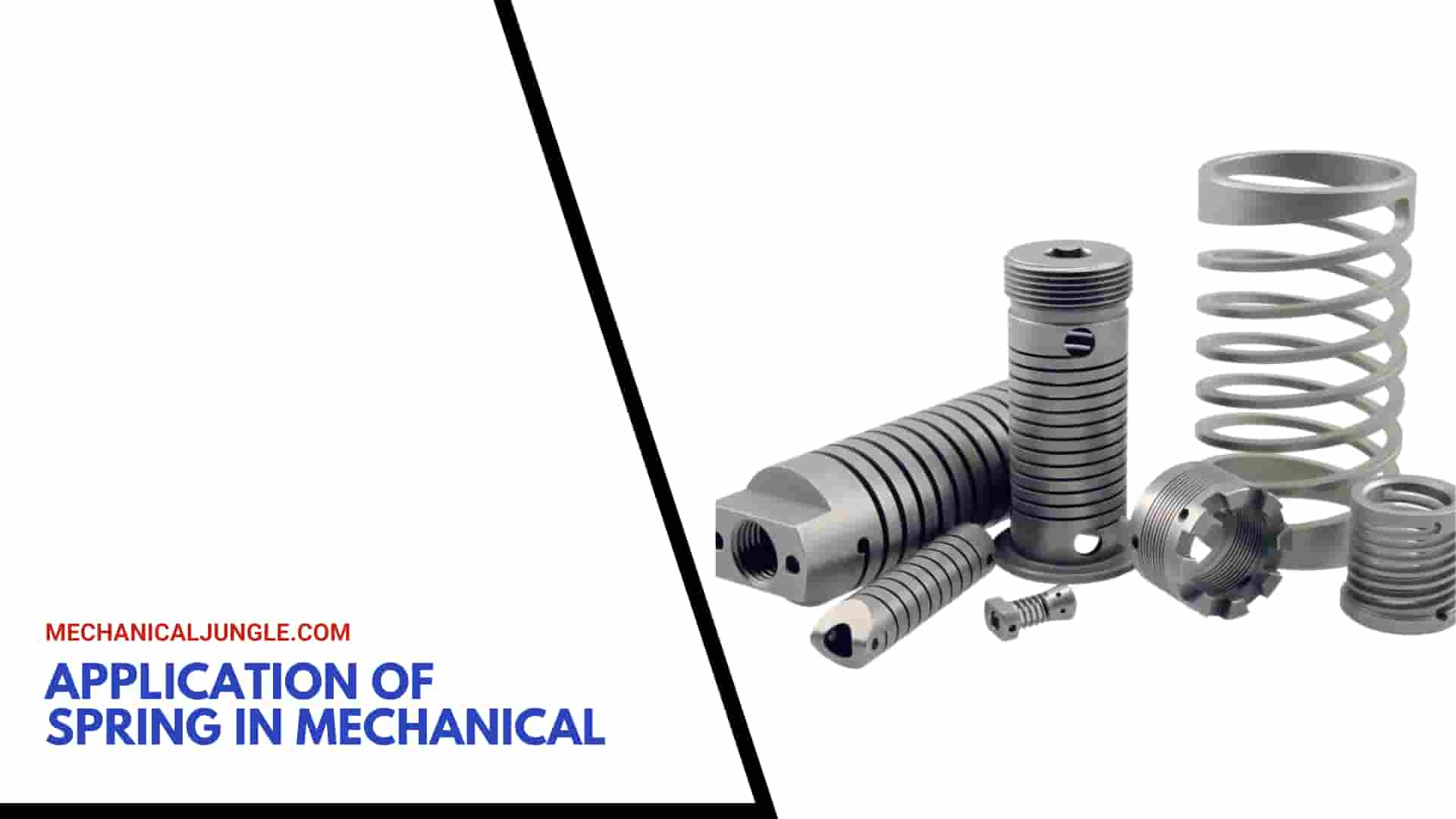
Springs are used in the following areas:-
- Automobile suspension system.
- In cam-follower assembly, we also use spring.
- Spring is used in railway bogies.
- We used spring in the clutches, brake, & valve assembly to apply force to these objects.
- Springs are used in garage doors, gardenings equipment, door locks, and many other household items.
Advantages of Spring in Mechanical:
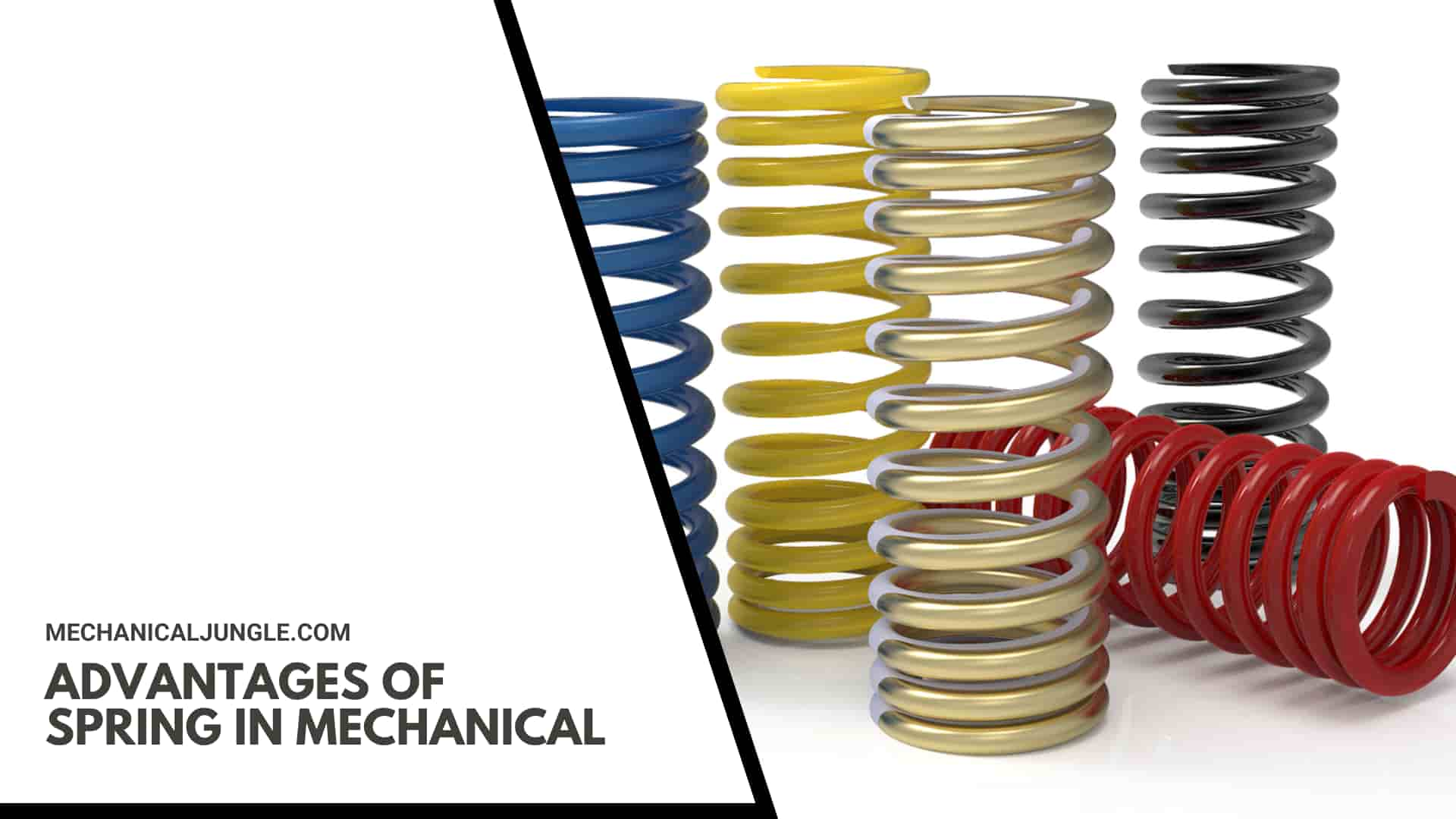
These are the following advantages of spring:
- Produce a good cushion effect.
- The spring has a good shock-absorbing ability.
- It has high durability.
- The spring has the potential for energy stored inside it.
- It is easy to design and cheap to produce.
- Spring is a maintenance-free device.
Disadvantages of Spring in Mechanical:
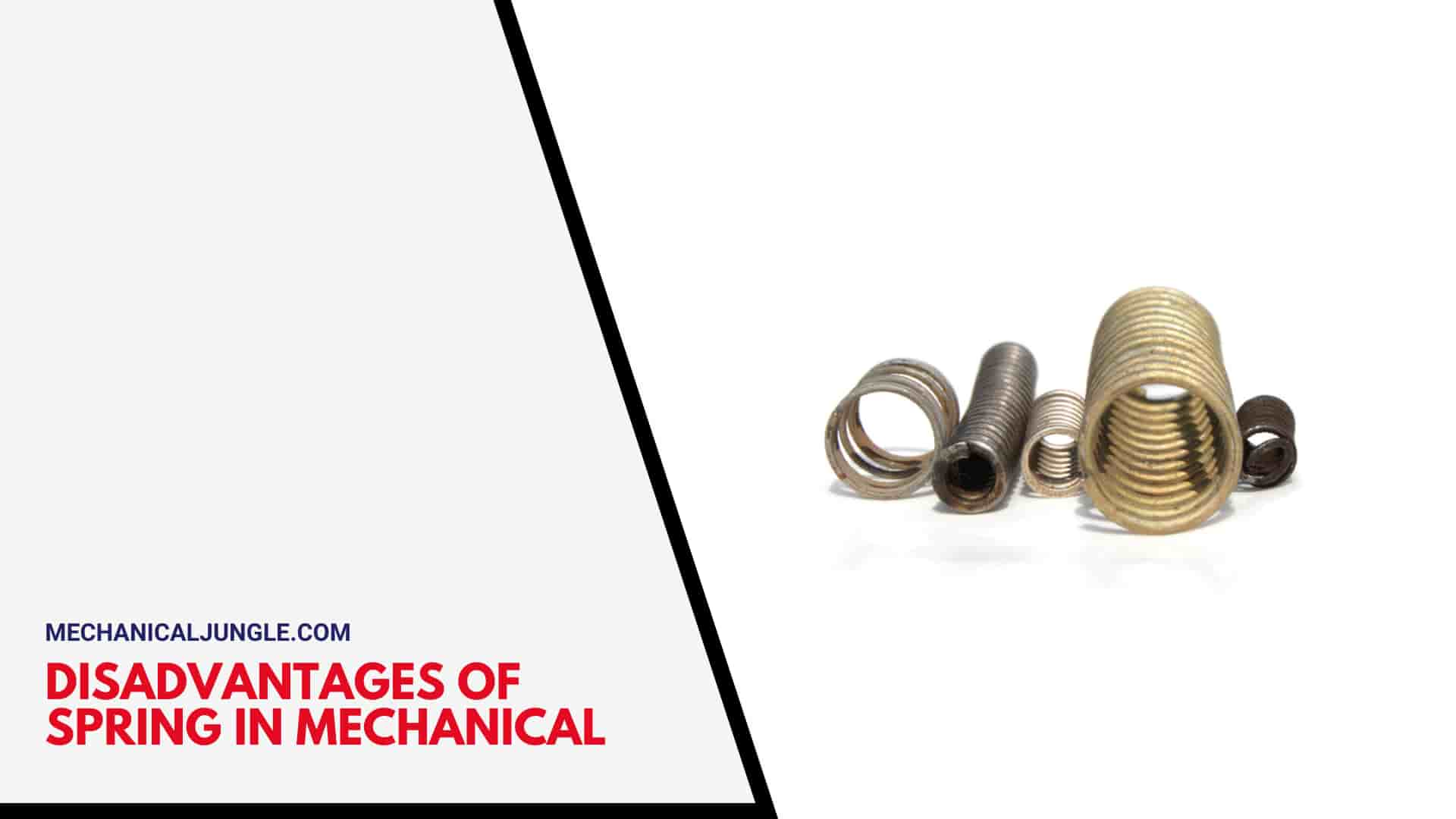
It has the following disadvantages in the spring:
- Its loose shape and stability from day Today.
- Sometimes, when the axial loads of the spring increase, it produces a buckling event.
- If the spring is broken, it is difficult to repair.
FAQ: Mechanical Springs
What Are Mechanical Springs?
Mechanical springs are devices that pull, push, wind, support, lift, or protect. They provide force in mechanical assemblies, including compressive, tensile, or torsion forces.
What Are the Main Functions of Mechanical Springs?
Mechanical springs deflect under the action of a load and return to their original shape when the load is removed. They are also used for storing energy and absorbing shocks in various machines.
What Materials Are Used to Make Mechanical Springs?
- Hard draw wires: For general-purpose springs with low-temperature resistance.
- Graphite epoxy: For high-strength applications like leaf springs.
- Carbon epoxy: Used in high-load applications, such as automobiles.
- Stainless steel: Widely used for its durability.
- Phosphor Bronze: Used in electrical industries for its conductivity and corrosion resistance.
- Chrome Silicon and Chrome Vanadium: Used in high-temperature applications.
What Are the Different Types of Mechanical Springs?
- Compression Springs: Provide compressive force.
- Torsion Springs: Apply or resist torque loads.
- Extension Springs: Provide opposing force when stretched.
- Constant Force Springs: Maintain constant force during contraction and expansion.
- Drawbar Springs: Combine tension and compression features.
- Volute Springs: Flat metal strips used in compression applications.
- Garter Springs: Spherical springs providing radial force.
- Flat Springs: Metal straps that provide a counterforce.
- Gas Springs: Use pressurized gas to create force.
- Air Springs: Air pressure devices for shock absorption and vibration isolation.
- Leaf Springs: Arc-shaped springs used in vehicle suspensions.
- Special Purpose Springs: Include air springs, gas springs, and extension springs for specific applications.
Where Are Mechanical Springs Commonly Used?
- Automobile suspension systems
- Cam-follower assemblies
- Railway bogies
- Clutches, brakes, and valve assemblies
- Garage doors, gardening equipment, and household items
What Are the Advantages of Mechanical Springs?
- Good cushion effect
- Excellent shock-absorbing ability
- High durability
- Energy storage potential
- Easy to design and produce
- Maintenance-free
What Are the Disadvantages of Mechanical Springs?
- Potential loss of shape and stability over time
- Risk of buckling under increased axial loads
- Difficulty in repairing broken springs
How Do Compression Springs Differ from Extension Springs?
Compression springs are designed to provide compressive force and compress under load, while extension springs provide opposing force when stretched and return to their original length when the load is removed.
What Is the Purpose of Torsion Springs?
Torsion springs apply or resist torque loads, making them suitable for applications requiring rotational force, such as in clocks and motion control mechanisms.
How Do Gas Springs Work?
Gas springs consist of a cylinder and rod, using pressurized gas to create a force bias on the piston or rod. They are commonly used in automobile hoods and office chairs for height adjustment.

